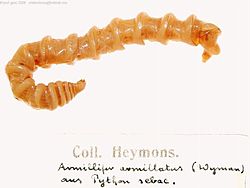| Armillifer | |
|---|---|
 | |
| Armillifer armillatus from the respiratory tract of Python sebae | |
| Scientific classification | |
| Kingdom: | Animalia |
| Phylum: | Arthropoda |
| Class: | Ichthyostraca |
| Order: | Porocephalida |
| Family: | Porocephalidae |
| Subfamily: | Armilliferinae |
| Genus: | Armillifer Sambon, 1922 |
| Synonyms | |
| |
Armillifer is a genus of tongue worms in the subclass Pentastomida. [1] [2] It contains the following species: [3]
- Armillifer aborealis Riley & Self, 1981
- Armillifer agkistrodontis Self & Kuntz, 1966
- Armillifer armillatus (Wyman, 1845)
- Armillifer australis Heymons, 1935
- Armillifer grandis (Hett, 1915)
- Armillifer mazzai (Sambon, 1922)
- Armillifer moniliformis (Diesing, 1836)
- Armillifer yoshidai Kishida, 1928